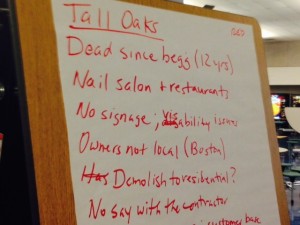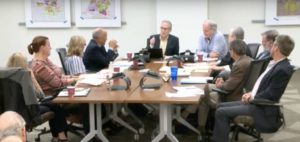At the last workgroup meeting on a controversial zoning amendment, county officials stressed that population density increases proposed in Reston’s comprehensive plan are broad targets that will be gradually implemented over the next 30 years.
The meeting, held Tuesday night, was the last in a series of discussions on the county’s proposal to increase Reston’s population density from 13 to 16 people per acre in the community’s Planned Residential Community district.
Representatives from the Coalition for a Planned Reston and Reston Association said that while they were not opposed to development, the cumulative impact of increased development without the infrastructure to manage it was a major concern.
Tammi Petrine, co-chair of Reston 2020, said increasing the density cap only invites more developers to push harder for development — a trend that she said is already clearly evident in the streak of major mixed-use projects approved by the Fairfax County Board of Supervisors.
Fred Selden, director of the Fairfax County’s Department of Planning and Zoning, said the community has multiple opportunities between when a development plan is proposed and passed to voice their concerns, suggest alternatives and raise critical issues.
“The community, quite frankly, has to give its judgment,” Selden said.
But others felt that concerns raised by community members have little sway in the overall planning process.
Selden said his office would be open to discussing possible changes to Reston’s comprehensive plan if pressing needs arose. In Tysons, the plan was updated seven years after its passage when the planned grid of streets did not align with what was actually being built.
But Selden also noted that major changes to planned land use intensities are rarely incorporated within five years of a plan’s passage. Late last year, CPR and RA suggested altering Reston’s master plan to make specific changes. He repeatedly stressed that Reston’s plan envisions possible future growth, which may or may not be realized given economic and market constraints.
Redevelopment of Reston’s village centers was also a hot topic during Tuesday’s discussion. Selden stressed that the plan already leaves the door open for high-density redevelopment potential — an element of the plan that was supported by some residents during earlier planning discussions.
“We could have said that there’s no redevelopment potential in the village centers,” Selden said. “But that’s not what we heard from the community.”
Others like John Mooney, a member on RA’s Board of Directors, said planning processes focus on the impacts of development in Transit Station Areas without considering the impact on development in all of Reston.
He said traffic studies have not considered the impact of traffic in Transit Station Areas on the rest of Reston.
“I see no evidence, although I’m awaiting further information,” Mooney said.
Photo via YouTube
(This story was updated on Wednesday at 6:27 a.m. to clarify a quote by John Mooney.)
 In the early 1960s, Reston founder Bob Simon and other planners got to work on what the community should look like — including village centers that would serve as the commercial and social hub of each of Reston’s villages.
In the early 1960s, Reston founder Bob Simon and other planners got to work on what the community should look like — including village centers that would serve as the commercial and social hub of each of Reston’s villages.
Fifty years later, village centers at Hunters Woods, South Lakes, Tall Oaks and North Point generally don’t look like what was planned. Lake Anne Plaza does fit the mold better, but is also undergoing a separate revitalization process.
What ended up serving Reston were essentially suburban shopping centers, heavy on parking spots and light on common areas.
With the second phase of Reston Master Plan up for review, might it be time to revisit the original ideals and work into the comprehensive plan the ability, should a developer want to do so, to revamp the village centers?
That was the main question posed by Fairfax County planners and Hunter Mill Supervisor Cathy Hudgins to participants who came to South Lakes High School Saturday to talk about the future of Reston’s Village Centers.
The village centers served as the model of Simon’s planning, said Hudgins.
“Some have survived over the years, some have not,” she said. “So this text is important — how do you trigger change? It may not happen in short time frame, but we want to be able to get this input on how the community thinks it should move forward.”
Fairfax County planning staff said Saturday they hope to have the final document drafted by mid-2015. But changes could be decades away, if ever.
Whatever changes are incorporated into the plan will not be a regulatory document and any structural changes will have to eventually go through the Reston Association’s Design Review Board, as well as county planning and zoning and the Board of Supervisors. Read More


